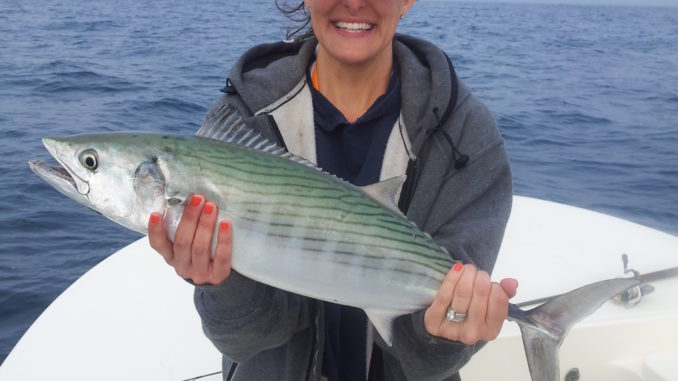
Great-tasting member of tuna family makes an April-May appearance along the coast.
A beautiful, spring morning became Wayne Crisco’s best bonito fishing adventure, and the Holly Ridge-based saltwater guide didn’t have a client on his boat.
“It was absolutely gorgeous on the ocean off Onslow Beach,” Crisco said. “You could see for miles because the seas were only 1 to 2 feet. I had brought my wife, Karen, with me but no clients.
“The first thing we noticed was schools of Spanish mackerel hitting baitfish out of New River Inlet. We were about 2 1/4 miles outside the inlet at the ledges where rocks are spread out across the bottom, and bonito were blowing up on schools of baby cigar minnows — not glass minnows like you’d expect.”
Crisco had outfitted 6 1/2-foot medium-fast Shimano rods with Stradic reels spooled with 15-pound monofilament and two feet of 40-pound fluorocarbon leader tied to 3/4- to 1-ounce Diamond jigs.
“I was expecting we’d catch Spanish mackerel, so you need a tough leader because Spanish’s teeth will bite through thin mono,” said Crisco, who runs Last Resort Charters. “Bonitos’ teeth aren’t as sharp as Spanish’s, too.”
The bonito were behind and above the schools of mackerel, so the Diamond jigs were a good lure choice — they catch either species, and bonito will slam them if you keep them near the surface.
Crisco and his wife found diving terns, gannets and sea gulls feasting on pieces of baitfish floating near the surface.
“Anytime you’re fishing for bonito, you need to look for birds diving on baitfish being chopped to pieces, move within casting distance, then throw at the back of the moving schools,” Crisco said. “The bonito were usually right behind the birds, and there were birds diving all over the ocean. I’ve never seen it quit like that.”
Crisco and his wife started casting and retrieving a couple of seconds after their lures hit the water.
“Most of the Spanish mackerel usually stay underneath the bonitos,” he said. “If you let jigs fall through a school of bonito, that’s when they’ll usually get hit by mackerel.”
But, Crisco said, when the bite is hot, bonito will strike almost as soon as lures hit the water — because they swim constantly, use enormous amounts of energy and don’t have any fat reserves.
“A lot of times, you’ll be hooked up, and it’ll get off, but another bonito will hit the lure before you can turn the reel handle,” he said.
Crisco, a 28-year-old guide who has lived at Topsail Island the past 13 years, said false albacore are often mistaken for bonito, and they’re more plentiful.
“Sometimes you’ll catch false albacore,” he said. “There seem to be more of them actually around than bonito, and they seem to stay within the same distances off the beaches for a longer period of time, so maybe that’s one of the reasons why people get them confused with bonito.”
Actually the main reason for misidentification probably is the two species’ similar size, color and shape.
To the untrained eye, false albacore, aka little tunny, and bonito are almost identical. Both are sleek, pelagic fish, shaped like miniature yellowfin tuna with scythe-like tails that give them powerful swimming strokes. After a couple of typical hook-ups with either species, especially using fly-fishing equipment, most anglers will be ready for a short respite.
The best way to tell the difference is to examine the dorsal fins and markings of both fish. A false albacore has a triangular-shaped dorsal fin that sticks up in the air, something akin to a shark, then it drops down to its back at about a 45-degree angle. From the dorsal almost to its tail, an albacore’s dorsal will have 14 to 16 spines. A bonito will have a shorter dorsal fin that gradually gets shorter as it extends down the middle of its back. Its dorsal fin will have 15 to 22 spines.
The other distinguishing characteristic of bonitos and false albacores are stripes along their sides just below the dorsal fins. A false albacore will have broken, wavy lines above its midsection from about halfway down its dorsal fin to its tail. A bonito will show smooth, unbroken lines that begin in front and below its dorsal fin.
Color probably is the main reason anglers confuse bonito and albacore. Both display silver bellies; bonito will show blue-green or steel-blue dorsal and upper flanks with silver lower flanks. A false albacore will have shoulders of blue-black or dark green and pale, silver flanks and a silver belly.
But there’s also no comparison between the two fish species when it comes to taste. False albacore, Euthynnus alletteratus, have red flesh and are too strong-tasting for most palates, while bonito, Sarda sarda, are one of the ocean’s best-eating species.
A drawback for anglers is that bonito spend a relatively short time along North Carolina’s coast each spring.
“The best time to find them is from mid-April through mid-May,” Crisco said. “I don’t know why, but that’s also when you can have good days catching really big Spanish mackerel. The big Spanish come within a mile or two of the beaches in the spring during a four- or five-week time.
“It may have something to do with the availability of bait. During April, we start to see big bait schools of cigar minnows, finger mullets, (menhaden) and glass minnows.”
Crisco said he’s found good bonito fishing near Spanish mackerel schools.
“My best day, we had a blast catching bonito, then we switched over to Spanish mackerel,” he said. “We put 14 in the boat that weighed 132 pounds. That was a 6- to 8-pound average, and that’s some nice Spanish. A guy who was commercial fishing that day caught 500 pounds.”
The only downside is the briefness of their appearance.
During their visit to North Carolina’s nearshore waters, bonito appear off beaches from Oregon Inlet to the Cape Fear region.
After their short spring stay, some bonito head north to spend the summer and fall off New England coasts. A resident population of bonito lives off the Florida coast.
Crisco, who fishes mostly off the Sneads Ferry beaches, has some favorite places to find spring bonito.
“Diver’s Rock is where everyone else goes, but I rarely get offshore that far,” he said.
It’s not that Crisco doesn’t head for that hot spot; he rarely makes it that far because he encounters bonito and Spanish mackerel before getting there.
“There are so many rocks and ledges that we usually find bonito before we ever get out that far. Bonito hold at other types of structure,” he said, describing rocks, reefs, ledges and wrecks that hold baitfish and attract gamefish.
“The baitfish like to stay deep, but the bonito push them to the top, and that’s when you can spot the birds diving and circling — and you’ll know where to fish,” Crisco said.
The best fishing, especially on bright days, occurs from just after dawn to mid-morning. After that, bonito are difficult to find.
“You most often get a bite when it gets light to 10 or 10:30 a.m. That’s when the sun angle usually is steep enough to push the bonito deep. That’s when I switch over and start fishing for Spanish mackerel,” said Crisco, who says the bite lasts longer on cloudy days.
The ideal water temperature for bonito is 63 to 64 degrees, he said, “but the bonito don’t always show up, even when the temperature is ideal.
“I think the ideal day to find bonito is when it’s very calm and you can see fish working bait schools and birds diving. You want calm winds and a calm surface.”
The bonito is a sporty fish on conventional spinning, baitcasting or fly tackle.
“When my wife and I got into that good school, she got hooked up using a baitcasting rod, but landing that fish nearly wore her out,” he said. “A bonito is like an albacore with the speed of a Spanish mackerel and the pull of a skipjack tuna. Landing just two or three bonito will wear you out.”
Crisco typically finds bonito when he’s out looking for mackerel.
“If you find bonito one day, they’ll likely be around in the same general area the next day,” he said, “so if you want to catch bonito, watch the weather and have someone at the coast you can contact who has been catching them and Spanish mackerel. If someone calls you and says, ‘The bonito are here,’ you better go right then.”
DESTINATION INFORMATION
HOW TO GET THERE — From spots west of the coast, follow I-40 south from Raleigh, exit at NC 24 toward Jacksonville, then south on US 17 to NC 210, then east on NC 172 to the Topsail/Sneads Ferry area.
BEST TIMES TO GO — Bonito will usually show up sometime in early to mid-April and stay around three to four weeks.
TACKLE/TECHNIQUES — Bonito are strong fish that require medium-action baitcasting or spinning outfits spooled with 15-pound test mono and a 2 to 2 1/2 feet of 40-pound fluorocarbon leader. Top lures include 3/4- to 1-ounce Diamond jigs, Stingsilvers or other lures that resemble small glass minnows. Rods should 7-footers to help with long casts often required to reach schooling fish.
GUIDES — Capt. Wayne Crisco Jr., Last Resort Charters, 910- 465-0611; Capt. Ricky Kellum, 910-330-2745 or www.speckledspecialist.com; Capt. Robbie Hall, Hall ‘Em In Charters; 910-330-6999; Capt. Jot Owens, Jot It Down Guide Service, 910-233-4139 or www.captainjot.com. See also Guides and Charters in Classifieds.
ACCOMMODATIONS — Onslow County Commerce Tourism, Jacksonville, 800-932-2144 or www.onlyinonslow.com.
MAPS — Capt. Segull’s Nautical Charts, 888-473-4855 or www.captainsegullcharts.com; Sealake Fishing Guides, 800-411-0185 or www.thegoodspots.com.

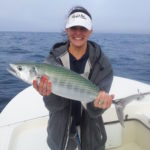
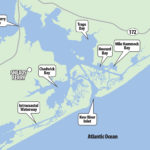
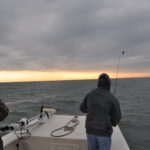
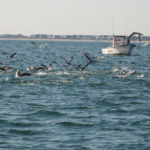
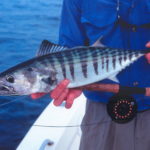
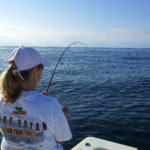

Be the first to comment